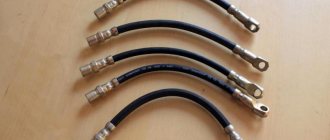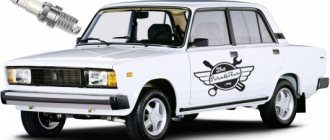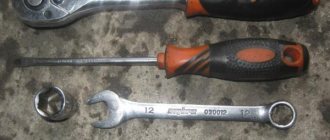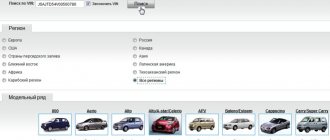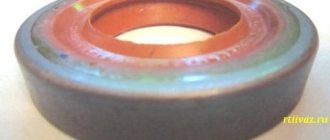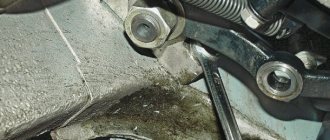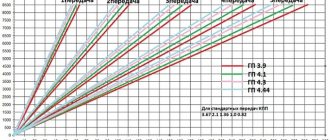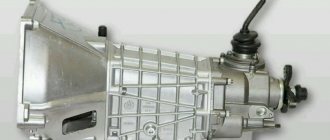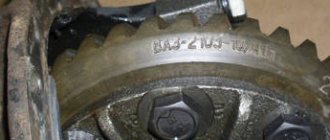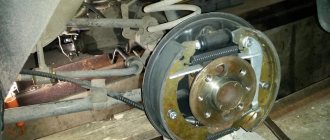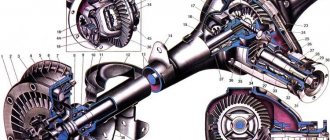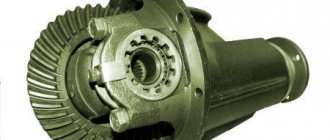On cars with rear-wheel drive and all-wheel drive, a common problem is extraneous sounds from the drive axle . Typically, the gearbox hums when the teeth of the main pair are worn or incorrectly adjusted. The problem requires urgent elimination, since the mechanism is difficult to repair. The source of a similar sound can be the bearings of the shank, axle shafts, hub, as well as the cardan outboard bearing.
We will tell you in this article how to determine the cause of the hum in the gearbox and how to solve this problem. We will analyze in detail the main symptoms of malfunctions and weak points of the transmission of specific models.
Why is the rear axle gearbox of the VAZ 2107 humming? Why is the bridge howling?
A considerable number of owners of classic Zhiguli cars wondered why the rear axle gearbox of the VAZ 2107 and previous models was humming. This unit was expensive at all times, and it is almost impossible to repair it yourself. When the rear of a car howls, all that remains is to clearly diagnose the problem and contact a good technician. And also understand the cause of the breakdown in order to avoid a repetition of the situation in the future.
Causes of malfunction
The VAZ 2107 rear axle gearbox is a complex and precise mechanism with a high degree of reliability. Nevertheless, for one car enthusiast it lasts the entire “life” of the car without the slightest problem, while another changes the gearboxes one after another, but the result is still the same. Based on practical observations, it is worth highlighting several reasons for the breakdown of the unit:
- operation of VAZ 2101-07 in extreme mode with overload;
- frequent slipping when moving from a stop;
- strong jerks when towing another car;
- loss of oil and dry driving;
- intervention of incompetent “masters”.
Driving with a heavy load means driving with an overloaded trailer and car. For such car enthusiasts, gearboxes fail very often. The same can be said about extreme sports enthusiasts who love to drive off to the sound of squealing tires. After such loads, the unit can howl at any moment.
The hum of the rear axle gearbox may occur after towing another car, when it needs to be pulled out of some hole or mud. For this reason, the mechanism on the Niva often suffers among fans of extreme off-road driving.
Loss of oil from the rear axle housing can occur for the following reasons:
- mechanical damage to the crankcase or “stocking”;
- failure of the oil seal on the shank or axle shaft plus the owner’s inattention to this problem;
- incompetent disassembly of any of the rear hubs when oil leaks from a skewed beam.
Separately, it is worth mentioning the actions of some “specialists” who interfere with the operation of the unit. A simple example: when replacing a crosspiece, a car mechanic discovers that the nut on the shank is loose, and tightens it with a wrench, but more firmly. As a result, the bearing is clamped to the limit, the spacer sleeve is deformed and wear appears on the teeth of the working pair, causing the rear axle to hum.
A humming sound coming from the gearbox can be caused by the addition of various additives to the lubricant of the unit. It is also possible to predict the occurrence of a hum when using oils that do not comply with the manufacturer’s recommendations.
As a rule, in 99 cases out of 100, a “sounding” unit must be repaired with the replacement of the main working pair of gears; it will not be possible to get by with “little loss.”
(K) The bridge howled | Topic started by: Baines
This kind of nonsense happened to me today.
Alexey (Manorama) Yes, you violated the gap.
Dima (Lucero) By the way, how can you understand that oil needs to be poured into the bridge by the sound??
Ravil (Jerok) Just shade the nut. There, the spacer sleeve won't be any worse.
Alexander (Zadie) Yes, on the contrary, maybe it’s too long. Oh my, what should I do?
Ravil (Jerok) OOOOO. If you have tightened it too much, then remove the gearbox, change the spacer sleeve, adjust the gear engagement ((((
Pavel (Teshaun) Well, try it at random. I took it off, turned the nut and went. If it buzzes then again. Well, if you don’t want to suffer, then go to a service center where there is special equipment that regulates it.
Alenka (Jonathon) and my toast bridge is buzzing!! ((what should I do?? I don’t know.
Anton (Mara) If adjusting the gap does not help, then replace the main pair or bearings. Or maybe it’s not the bridge that’s buzzing at all??
Vlad (Edgard) At 70 km/h the jammed crosspiece begins to howl. This sound is often confused with the hum of a gearbox. I myself also sinned at first on the bridge, but I changed the crosspiece and the noise stopped.
Sergey (Gaia) Nonsense, if it howls, then all six gearboxes cannot be repaired, I checked it myself. easier to change. Pavel Kuzovnikov, the shank nut must be tightened, otherwise vibration will begin.
Dmitry (Paula) sometimes the satellites in the differential (on the axle shafts) begin to dangle, howling and vibration begin
Ilya (Chev) my bridge has been howling for as long as I can remember. but it howls only in 4th gear.. somewhere from 50 km/h to 80 (it may continue to hum, but then you can’t hear it because of the engine) But the very fact that it hums in 4th surprises me.
Sergey (Gaia) will fall off kada thread nah tada you will increase even more
Alenka (Jonathon) You want to say. completely change the axle gearbox?? what if you drive like this? Doesn't it affect the speed? But with music you can’t hear)))) or will it fall apart? and if it also jams. that's fucked up. ((((((
Anton (Mara) Why the whole gearbox? Usually it is enough to replace the shank and planetary gear, as well as the bearings, and everything stops humming. Mine was buzzing, but not much, for about 2 years then it fell apart, it didn’t jam well on the shank, only 4 teeth remained intact)))
Ilya (Chev) uh. scared me. Although I was going to change the gearbox soon, it would be so critical. Damn, this way I won’t even be able to get home, or what? ! o_O If you don’t exceed the speed limit, will you live longer? or does he give a fuck??
Diagnostics of the mechanism by sound
It is very important to catch the moment when the gearbox just begins to hum. Then there is a chance to save a little on repairs. Usually, when the main pair is exhausted, the howl begins to appear at a speed of 60-80 km/h. If you do not pay attention to it, the hum will spread over a wider range of speeds and will become audible already at 40 km/h. Completely neglected units begin to hum at 20 km/h, and at a speed of 80-100 km/h it is impossible to even talk inside the car.
Experts recognize the following types of humming sounds from the rear axle:
- The howl is heard only when driving “under load”, that is, when the accelerator pedal is pressed. If you release it, the sound disappears.
- Constant hum that only stops when the car stops.
- Crunching sounds. Their frequency depends on the speed of the vehicle.
- "The trolleybus effect." A howl, similar to the noise of an approaching trolleybus, occurs only when the accelerator pedal is released, provided that some speed is turned on. If you coast in the neutral position of the gearbox, the sound becomes much quieter, but does not disappear completely.
A whine under load indicates that wear has appeared on the gear teeth. At the initial stage, good craftsmen sometimes manage to eliminate the malfunction with adjustments, but this does not last long. You should prepare to replace the shank and planetary gear. An incessant whine indicates wear on the shank bearings. If they are not changed in a timely manner, production will appear on the main steam.
Crunching noises are produced by worn differential bearings, and the “trolleybus” appears due to a loose or completely unscrewed nut on the shank. This malfunction is especially dangerous, since if the nut is unscrewed, the teeth of the drive gear can break at any time. Therefore, it must be eliminated immediately, otherwise the broken teeth may jam the entire mechanism.
How and when the gearbox howls if the main pair is worn out
If the VAZ gearbox hums when accelerating, and the sound is howling, without crunches or loud knocks, then the problem is the wear of the main pair - the drive and driven gears. An even more obvious sign of this malfunction is that the howl is not audible when braking the engine. Often the sound intensifies when the load changes (pressing or releasing the accelerator pedal). As a rule, the driver begins to notice that the rear gearbox howls when driving at speeds of about 80 km/h. On an all-wheel drive Niva, the front axle sometimes hums, but usually faults “sneak up from behind.” The rear gearbox of a Russian SUV is constantly in operation, so it wears out faster. You can read about what problems can arise in a manual transmission and how to solve them in our article: “Transmission problem - manual transmission, gearbox”
What to do about it
If you take timely measures, you can avoid costly repairs. As soon as you hear for the first time that the rear gearbox is humming , add the tribotechnical compound “Reducer” from Suprotec to the transmission oil.
Getting into the lubricating liquid, the product forms a protective layer on the surface of metal parts. Microdamages are leveled out, and the geometry of the gears is partially restored. The product does not react with lubricants, ceramics, rubber or plastic.
If, despite the fact that the gearbox howls , you continue to drive, having driven 1000 kilometers or more, you will have to change the main pair. It is possible that the entire assembly will need to be replaced. It would be wiser not to go to such an extreme.
Suprotek Reducer additive for transmission units
Restores the surfaces of gear teeth and bearing races in gearboxes of any type. This reduces noise and vibration during operation of the unit, facilitates its operation, and extends its service life by 2.5-3 times.
more reviews
Clarifying the diagnosis
Many motorists, out of ignorance, confuse noise from the gearbox with other faults, and then begin to change completely working parts. Often they are helped in this by garage “masters” who are incompetent in the work of gearboxes. Following their advice, the owner of a VAZ 2106 can pour some additive into the crankcase of a working gearbox, which will disable it. This cannot be done; additives will not restore a humming unit, but they can ruin a working one.
To make an accurate diagnosis, you need to check the following points:
- make sure there is lubricant in the crankcase;
- check if the seals are leaking;
- measure the amount of play in the mechanism.
The backlash is determined by freely turning the cardan manually and placing marks on it and the gearbox housing. The ideal backlash is 2-3 mm, the acceptable one is 10 mm.
In order not to confuse the noise from the gearbox with the hum of axle bearings or the crunching of crosspieces, it is recommended to perform an on-site hearing test. To do this, you need to, together with an assistant, hang the rear of the car so that both wheels do not touch the ground. After starting the engine, turn on the gear and listen in different modes to where the sound source is. The procedure is performed on an inspection ditch or lift.
If you find an error, please select a piece of text and press Ctrl+Enter.
Rear axle gearbox on VAZ 2107: design, repair, replacement
The occurrence of extraneous noise in the rear part of the VAZ 2107 engine (humming) while driving may be a signal of problems in the rear axle gearbox or axle shafts. Even if the oil change in the rear axle is carried out in accordance with the requirements of the regulations, wear of its parts is inevitable. In order to ensure that the diagnosis is correct, a number of additional measures should be performed:
- When driving on a flat road, you should ensure smooth acceleration of the VAZ 2107 from 20 km/h to 90 km/h. In this case, it is necessary to note for yourself the appearance and disappearance of extraneous noises in the rear, the driving speed at which they appear and disappear. Next, you should release the gas pedal and apply engine braking. In this case, it is again necessary to monitor the appearance and disappearance of noise.
- Having accelerated the car to a speed of approximately 100 km/h, you need to switch off the gear, turn off the engine and let the car roll by inertia. Again, we notice a change in noise in the chassis. If the chassis hums as noted when performing step 1. - this indicates that there are no problems in the main gear and rear axle differential. If the noises detected in step 1 are absent when performing step 2, then everything is not so good with the rear axle of your car.
- Having placed the VAZ 2107 on the handbrake and secured it with wheel chocks, start the engine and ensure a gradual increase in speed. If the noise is the same as in step 1, it means that the gearbox is fully operational and you should look for the problem elsewhere.
- If the noise that you heard during the first test could not be repeated using another method, then you will have to take a closer look at the gearbox. You can verify that the conclusions drawn are correct by starting the engine, engaging the gearbox in fourth gear and releasing the clutch, thereby activating the entire chassis. This will allow you to hear the gearbox hum.
Reasons for the appearance of hum in the gearbox
To diagnose a car, you should drive the inspection hole or onto a lift. There you should start the engine with the wheels hanging out, engage the gear, and determine what exactly is making the unwanted sounds. Some verification methods (mentioned above) are used on the go.
You need to start checking by inspecting the gearbox housing, axle shafts, and measuring the oil level. If its level is insufficient, noise occurs not due to wear, but because the gears rub dry. If a leak is detected, then only replacing the seals and oil can help with a timely response.
After making sure that the sound comes from the GP (Main Pair), you can use it to determine why the gearbox is humming. You can figure out more specifically why the gearbox howls, determine exactly whether it is it, and determine the cause by the nature of the sound, as well as by indirect signs. Characteristic symptoms of its various malfunctions are listed in the table below.
Why the gearbox hums: causes and description of the noise
| Causes of hum in the gearbox | Characteristic symptoms of a malfunction | Why is there a problem? | What can this problem be confused with? |
| Noise in the gearbox due to bearing wear | The hum is “humming”, constant, and does not disappear in any driving mode. | Natural production of bearings. | Worn driveshaft outboard bearing or hub bearing. |
| Excessive tightening of the shank. | |||
| Gearbox hums due to low oil level | A howl that intensifies as the speed increases. Occurs during acceleration, engine braking and coasting. Oil leaks on the shank, from under the cap, plug or on the axle shaft stockings; the lubricant level is much lower than the level of the filler hole. | Oil leaks through worn seals, insufficient volume when filling. | Noise from wheels, gearbox, worn out suspension or wheel bearing. |
| Gearbox hum due to wear of the shank oil seal | Constant rhythmic hum of bearings in any driving mode. Oil leaks from the shank side. | Natural wear of the oil seal. | Howling can occur when bearings wear in other places (differential, axle shaft, hub). |
| Unqualified oil seal replacement. | |||
| It's buzzing due to wear on the main pair. | A hum that increases with acceleration and disappears when the engine brakes, when coasting, in neutral or with the clutch disengaged. As wear continues, it appears at a lower speed. | Natural production of GP. | Extraneous sounds in the engine and gearbox. |
| Aggressive driving with frequent sudden starts and throwing off the gas pedal. | |||
| Incorrect gearbox adjustment. | |||
| The shank nut is overtightened or undertightened. | |||
| The gearbox hums after incorrect adjustment | Most often, the hum is absent when coasting in neutral, but appears when accelerating and braking the engine. The problem appears only after intervention in the gearbox. | Unqualified adjustment or repair of the gearbox. | The symptoms are similar to those of wear on the main pair. |
| Gearbox hums due to unscrewed shank nut | During acceleration, there is no noise or it is minimal, but when releasing the gas and braking the engine, a “trolleybus” hum appears. The shaft seal is leaking. | Spontaneous loosening of fasteners. | A similar sound is typical for some serviceable gearboxes when engine braking. |
| Insufficient tightening of the nut or lack of locking. | |||
| Bearing wear. |
Removing the gearbox
Before starting work, that is, before starting to remove the rear axle gearbox of the VAZ 2107, it is necessary to drain the used oil from it. To do this, you need to unscrew the drain plug at the bottom of the rear axle, first placing a container to collect the oil. Typically, repairs involve replacing used oil with new oil.
Next, unscrew the screws securing the propeller shaft flange and disconnect it from the shank. Jack up the rear of the car and remove the rear wheels. After unscrewing the guide screws, remove the brake drums to gain access to the axle shafts. Having unscrewed the bolts securing the axle shafts (4 pcs.), we remove the axle shafts from the rear axle, thereby completely freeing the gearbox. All that remains is to unscrew the bolts securing the gearbox to the rear axle beam and remove it. After removing the axle shafts, it is recommended to check whether the bearings require replacement.
Design and principle of operation of the gearbox
To understand why the gearbox howls and how to “treat” it, you need to understand the device and the principle of its operation. The name of the node comes from the English word meaning “to lower.” In this mechanism, the rapid rotation of the driveshaft shank is transmitted to the wheels with a decrease in speed.
An automobile gearbox transmits torque from the gearbox to the axle shaft through a system of gear mechanisms. The drive gear is mounted on the driveshaft shank and transmits the moment of force to the driven gear of the gearbox. This is the so-called main pair. The reduction occurs due to the fact that the driven gear has more teeth than the driving gear.
The distribution of torque between the axle shafts is carried out through a differential - a system of bevel gears called satellites. This mechanism allows the wheels to move at different speeds as the car makes a turn.
Repair and adjustment
Both repairs and subsequent adjustments require special skills and professional equipment; stands, pullers, special tools. Therefore, we will consider only the general principles by which repairs and post-repair adjustments of the gearbox are carried out in order to assess the required amount of work and the costs of purchasing spare parts.
The gearbox structure can be viewed in the following diagram:
Disassembling the gearbox begins with unscrewing the shank nut. After removing the flange, the drive gear with adjusting rings, oil seal, oil deflector, and inner bearing ring are removed. Then we press out the outer rings of the bearings. Lastly, the drive gear and differential are disassembled. When completely disassembled, the spacer sleeve is discarded.
It is not recommended to carry out the work described above related to disassembling the VAZ 2107 gearbox, due to its complexity. This is a rare case when you shouldn’t skimp on the services of specialists.
Most often, the bearings and the main pair of this unit fail, for which replacement with new ones is provided. It should be noted that it is the main pair that determines the gear ratio. There are three standard varieties of the main pair, with different gear ratios. The higher this number, the higher the power; the lower, the higher the speed of the gearbox. When replacing these parts, the spacer sleeve must be replaced, since it is disposable.
Some car enthusiasts use final drives as a way to tune their cars. By installing a main gear with a reduced gear ratio in the VAZ 2107 gearbox, they significantly increase the maximum speed of their car. In principle, the gear ratio can be selected for all rear-wheel drive cars without exception, guided only by your own needs. The gearbox of the VAZ 2102 had the largest gear ratio - 4.4. But after it was discontinued, finding a main pair with the same gear ratio became extremely problematic.
Repair is not advisable in all cases. For a rear axle gearbox that is too worn, it is more profitable to completely replace it with a new one. The difference in price will be compensated by the reduction in the cost of work performed by specialists and the durability of the new unit.
Why is the rear axle gearbox humming on the VAZ 2107 and Niva?
A considerable number of owners of classic Zhiguli cars wondered why the rear axle gearbox of the VAZ 2107 and previous models was humming. This unit was expensive at all times, and it is almost impossible to repair it yourself. When the rear of a car howls, all that remains is to clearly diagnose the problem and contact a good technician. And also understand the cause of the breakdown in order to avoid a repetition of the situation in the future.
Causes of malfunction
The VAZ 2107 rear axle gearbox is a complex and precise mechanism with a high degree of reliability. Nevertheless, for one car enthusiast it lasts the entire “life” of the car without the slightest problem, while another changes the gearboxes one after another, but the result is still the same. Based on practical observations, it is worth highlighting several reasons for the breakdown of the unit:
- operation of VAZ 2101-07 in extreme mode with overload;
- frequent slipping when moving from a stop;
- strong jerks when towing another car;
- loss of oil and dry driving;
- intervention of incompetent “masters”.
Driving with a heavy load means driving with an overloaded trailer and car. For such car enthusiasts, gearboxes fail very often. The same can be said about extreme sports enthusiasts who love to drive off to the sound of squealing tires. After such loads, the unit can howl at any moment.
The hum of the rear axle gearbox may occur after towing another car, when it needs to be pulled out of some hole or mud. For this reason, the mechanism on the Niva often suffers among fans of extreme off-road driving.
Loss of oil from the rear axle housing can occur for the following reasons:
- mechanical damage to the crankcase or “stocking”;
- failure of the oil seal on the shank or axle shaft plus the owner’s inattention to this problem;
- incompetent disassembly of any of the rear hubs when oil leaks from a skewed beam.
Separately, it is worth mentioning the actions of some “specialists” who interfere with the operation of the unit. A simple example: when replacing a crosspiece, a car mechanic discovers that the nut on the shank is loose, and tightens it with a wrench, but more firmly. As a result, the bearing is clamped to the limit, the spacer sleeve is deformed and wear appears on the teeth of the working pair, causing the rear axle to hum.
A humming sound coming from the gearbox can be caused by the addition of various additives to the lubricant of the unit. It is also possible to predict the occurrence of a hum when using oils that do not comply with the manufacturer’s recommendations.
As a rule, in 99 cases out of 100, a “sounding” unit must be repaired with the replacement of the main working pair of gears; it will not be possible to get by with “little loss.”
Weaknesses of gearboxes on popular cars
Some car models are more prone to noise in the gearbox than others. Their main cause is the deterioration of the main pair and bearings, caused by lubricant leakage or loss of its properties. Common causes of gearbox hum on popular cars are collected in the table below.
| Automobile | What causes hum most often? | Why is this happening | Countermeasures and prevention |
| Chevrolet Niva and VAZ Niva, 2101-2107 (Lada “classic”) |
| Sudden starts from a standstill, especially off-road. |
|
| BMW e90 and x5 e70 | Differential bearings wear out | Untimely oil change, drain plug, which is not on the body. | Change the oil at least once every 25 thousand km |
| Nissan X-Trail | The shank nut is unscrewed | The design predisposition of the nut to unscrew. | Check the tightening of the shank nut, tighten it according to the torque specified in the manual. |
| Gazelle |
|
| Check the tightening of the nut, the condition of the seals and the oil level |
| Suzuki Grand Vitara | Oil leak from the front axle gearbox | Due to premature wear of the oil seal (often up to 50 thousand km), oil leaks and the gearbox teeth wear out quickly. | Monitor the condition of the oil seal, change the oil at least every 25 thousand km. |
| Subaru Forester |
| On Subaru, either the GP itself or the front shank bearing usually howls due to untimely oil changes. | Change the oil on time using high-quality transmission fluid. |
| Toyota RAV 4 | Wear of the rear drive clutch bearing | When oil runs out or becomes contaminated, the clutch bearing wears out, causing a whine. | Keep the oil clean and change it promptly. |
| Hyundai Santa Fe | Drive shaft bearing wear | The drive shaft bearing suffers from oil leakage or untimely replacement, which causes the GP to fail | Change the oil on time Check the condition of the seals |
| Mitsubishi Outlander 3 | Development of the main pair | Due to untimely oil changes, the gearbox may begin to howl under load. | Change the oil in the gearbox in a timely manner. |
| Land Rover Freelander 2 | Wear of the front bearing of the main pair | Loss of transmission fluid properties, wear products. | Monitor the oil level and its cleanliness, change the oil if there is contamination and/or noticeable chips on the plug magnet. |
Diagnostics of the mechanism by sound
It is very important to catch the moment when the gearbox just begins to hum. Then there is a chance to save a little on repairs. Usually, when the main pair is exhausted, the howl begins to appear at a speed of 60-80 km/h. If you do not pay attention to it, the hum will spread over a wider range of speeds and will become audible already at 40 km/h. Completely neglected units begin to hum at 20 km/h, and at a speed of 80-100 km/h it is impossible to even talk inside the car.
Experts recognize the following types of humming sounds from the rear axle:
A whine under load indicates that wear has appeared on the gear teeth. At the initial stage, good craftsmen sometimes manage to eliminate the malfunction with adjustments, but this does not last long. You should prepare to replace the shank and planetary gear. An incessant whine indicates wear on the shank bearings. If they are not changed in a timely manner, production will appear on the main steam.
Crunching noises are produced by worn differential bearings, and the “trolleybus” appears due to a loose or completely unscrewed nut on the shank. This malfunction is especially dangerous, since if the nut is unscrewed, the teeth of the drive gear can break at any time. Therefore, it must be eliminated immediately, otherwise the broken teeth may jam the entire mechanism.
Repair or replacement, which is better?
Car owners of VAZ classics often cannot decide what is best to do - buy a complete ready-made REM assembled or purchase individual parts and repair the gearbox. It’s really difficult to decide here - the price of a new gearbox, of course, is higher, but the owner of the car is freed from the headache of adjustment. The thing is that it’s not so easy to find a good specialist in VAZ gearboxes, and there is no guarantee that the new main pair will not hum.
If a car owner buys a new gearbox, but it hums, the part can be exchanged under warranty, but the car owner loses money on removing and installing the gearbox. If you purchase a defective main pair, the repair itself will be more expensive - you will have to pay a technician for a secondary overhaul of the gearbox.
Clarifying the diagnosis
Many motorists, out of ignorance, confuse noise from the gearbox with other faults, and then begin to change completely working parts. Often they are helped in this by garage “masters” who are incompetent in the work of gearboxes. Following their advice, the owner of a VAZ 2106 can pour some additive into the crankcase of a working gearbox, which will disable it. This cannot be done; additives will not restore a humming unit, but they can ruin a working one.
To make an accurate diagnosis, you need to check the following points:
- make sure there is lubricant in the crankcase;
- check if the seals are leaking;
- measure the amount of play in the mechanism.
The backlash is determined by freely turning the cardan manually and placing marks on it and the gearbox housing. The ideal backlash is 2-3 mm, the acceptable one is 10 mm.
In order not to confuse the noise from the gearbox with the hum of axle bearings or the crunching of crosspieces, it is recommended to perform an on-site hearing test. To do this, you need to, together with an assistant, hang the rear of the car so that both wheels do not touch the ground. After starting the engine, turn on the gear and listen in different modes to where the sound source is. The procedure is performed on an inspection ditch or lift.
Hum on VAZ-2107
During the operation of a VAZ-2107 car, sometimes unexpected sounds arise, which are accompanied more and more often. Any extraneous sound for the car is evidence that a part is worn out and requires repair or replacement. The most important thing in such situations is to correctly determine the source of extraneous noise, because sometimes it is so unpredictable that it is very difficult to determine where it comes from. The article will tell you the main places where a breakdown may occur, accompanied by the appearance of a hum.
Noises from the bridge
So, a hum from the rear axle of a VAZ-2107 car is the most common phenomenon that scares not only the driver, but also passengers. If a hum occurs in the bridge, you must first try not to operate the car until it is eliminated, because these noises indicate serious problems that may arise on the road. What needs to be done first to eliminate the causes of the hum and protect your life?
- Oil level. First of all, a ringing sound on the rear axle when driving may indicate a decrease in the permissible oil level in the system. It is especially necessary to analyze if the car has low mileage, then most likely this is the case. Therefore, it is necessary to check the oil level in the bridge and add if necessary.
- Curved axes. If the reason for the hum on the rear axle was not a low oil level, then most likely you were less fortunate and the reason was bent axles. This type of damage occurs over long periods of use of the car, especially when the “seven” covered roads with poor road surfaces. Or when there was a noticeable impact on the road with the rear axle, so it is urgent to get repairs. It is better to entrust the replacement of axles to professionals, but if you wish, you can do it yourself.
- Unsuitability of axle bearings. Often occurs in conjunction with bent rear axle axles. Operating the car is strictly prohibited, because the unsuitable condition of the bearing leads to its crumbling right on the road. Therefore, it is necessary to replace the bearings and continue operation without extraneous noise.
- Other causes of malfunctions. Often the cause of extraneous noise on the rear axle when driving can be problems with gear misalignments due to loosening of the gears. Therefore, the bridge will need to be dismantled to carry out repair work. Perhaps a hum when driving indicates a faulty differential, which can be detected by rotating the satellites. If it is necessary to exert maximum effort to rotate it, then this is evidence of its malfunction and misalignment due to loosening of the fastenings. In any case, the fault can only be detected by disassembling the bridge.
Problems in the axle shafts
Sometimes the rear axle hum is not melodic at all . If you hear a crunching sound when you press the accelerator pedal or, conversely, when you release the gas, the problem may lie in the axle shafts. The sound is so sharp that it seems that the unit is running without lubrication or that a foreign object has entered it.
This is how the worn-out bearings of the drive axle axles make noise. Sometimes it is enough to change these spare parts to make the sound go away. In some cases, the cause of a hum in the rear axle is deformation of the axle shafts. If you like to jump over speed bumps at full speed, jump curbs or rush off-road, this problem is quite likely.
